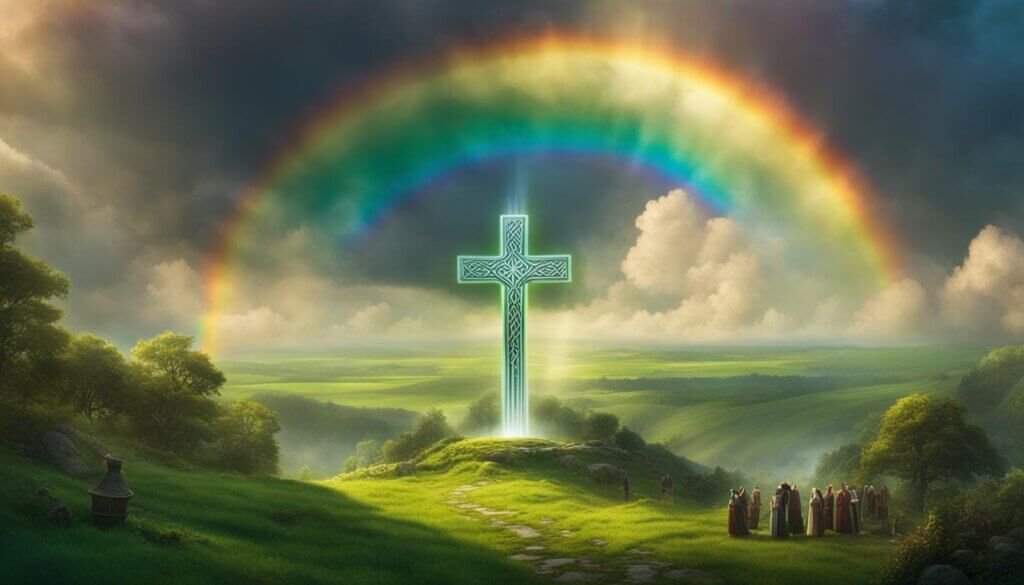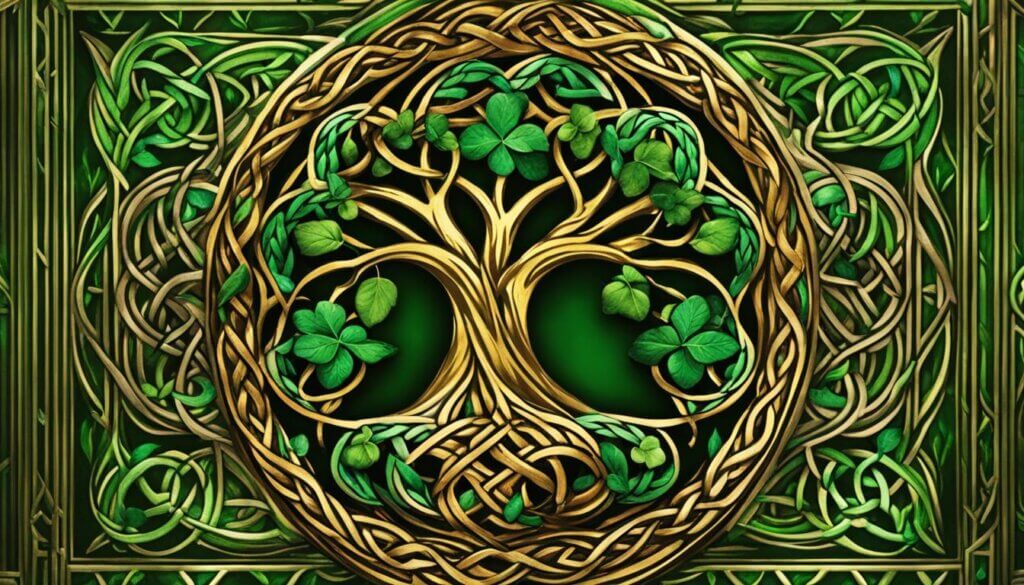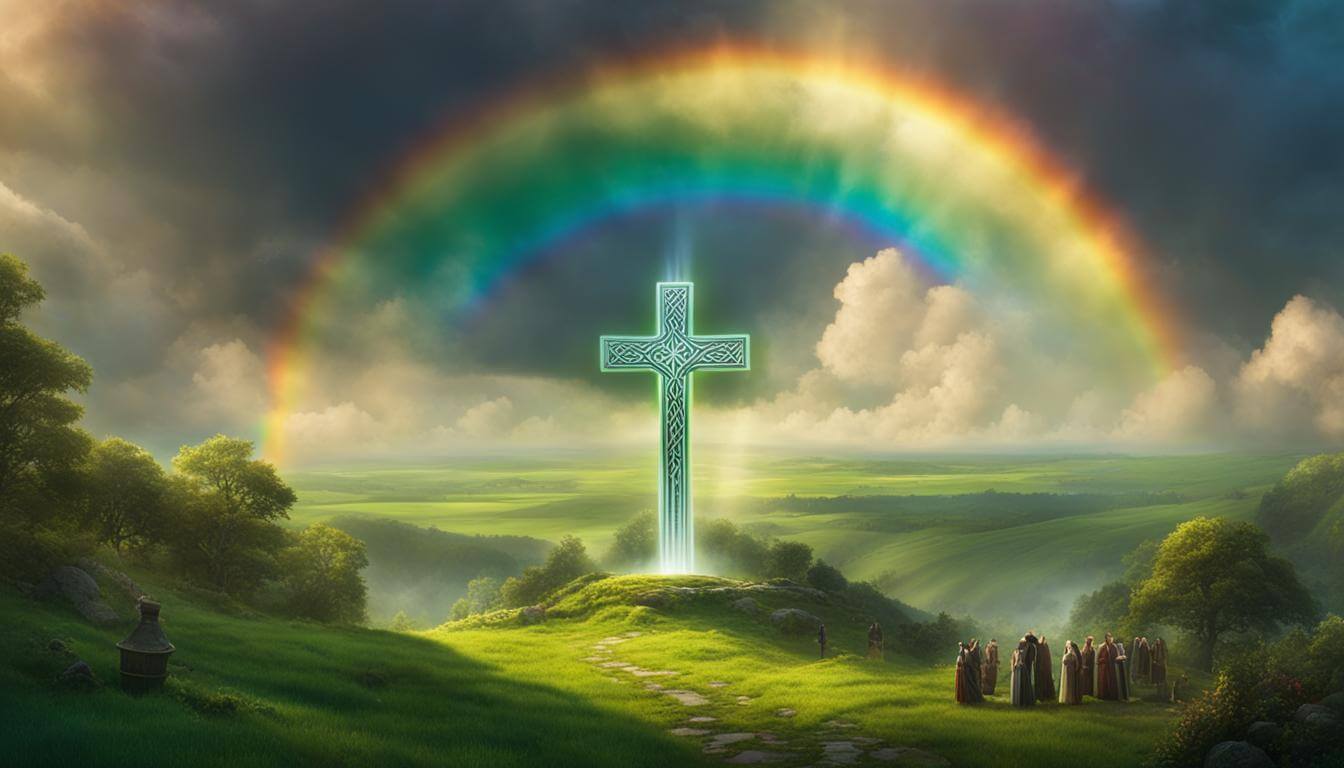As the annual holiday of St. Patrick’s Day approaches, it’s important to delve beyond the green festivities and uncover the deeper spiritual significance behind this celebrated day. Originally rooted in religious aspects, St. Patrick’s Day has evolved into a cultural and spiritual experience that allows us to connect with our spirituality, reflect on the teachings of St. Patrick, and celebrate Irish heritage.

Key Takeaways (Spiritual Meaning of St. Patrick’s Day):
- St. Patrick’s Day is an opportunity to honor the life and work of St. Patrick, the patron saint of Ireland.
- It has evolved over time to encompass broader cultural and spiritual meanings.
- The holiday allows us to celebrate Irish heritage, connect with our spirituality, and reflect on the teachings and values associated with St. Patrick.
- Symbols such as the shamrock represent the Holy Trinity and offer a deeper spiritual connection.
- Legends and superstitions surrounding St. Patrick’s Day add to its spiritual significance and cultural richness.
The History and Origins of St. Patrick’s Day
St. Patrick’s Day, celebrated on March 17th, has a rich history that dates back to the late 4th century. It all begins with St. Patrick, a Christian missionary who arrived in Ireland to spread the message of faith and convert the Irish people to Christianity. His teachings and influence had a profound impact on the country, ultimately leading to the establishment of a holiday in his honor.
Originally, St. Patrick’s Day was observed as a religious holiday, commemorating the death of St. Patrick. Over time, it evolved into a celebration of Irish culture and heritage. Today, it is a global phenomenon, with people from all walks of life joining in the festivities.
To fully understand the origins of St. Patrick’s Day, it’s important to delve into the traditions and customs associated with the holiday. From wearing green to attending parades and indulging in traditional Irish food and drink, these practices are deeply rooted in Irish history and have become an integral part of the celebration.
The History and Origins of St. Patrick’s Day: A Brief Timeline
| Year | Event |
|---|---|
| 5th Century | St. Patrick arrives in Ireland as a Christian missionary. |
| 17th Century | The feast day of St. Patrick is officially recognized by the Catholic Church. |
| 1762 | The first St. Patrick’s Day parade is held in New York City by Irish soldiers serving in the British army. |
| 1903 | The first St. Patrick’s Day parade is held in Ireland, in Waterford. |
| 1995 | St. Patrick’s Day becomes a public holiday in Ireland. |
As St. Patrick’s Day continues to evolve and be celebrated around the world, it remains deeply rooted in the history and culture of Ireland. Whether you’re Irish or not, the holiday provides an opportunity to learn, appreciate, and celebrate the rich heritage of the Emerald Isle.

Create an image that depicts the spiritual origins of St. Patrick’s Day, showcasing the connection between the holiday and the early Catholic Church in Ireland. Use vivid colors to capture the ancient traditions and symbols associated with the celebration, including the shamrock, leprechauns, and Celtic crosses. Incorporate elements of nature such as rolling hills, rivers, and rainbows to suggest the rich cultural heritage and natural beauty of Ireland. Show how St. Patrick’s Day has evolved over the centuries from a religious observance to a secular holiday celebrated around the world.
Continue reading the next section to explore the spiritual significance of St. Patrick’s Day.
The Spiritual Significance of St. Patrick’s Day
St. Patrick’s Day holds deep spiritual meanings for many people. It is a time to celebrate the life and work of St. Patrick, a symbol of spiritual commitment and devotion. The holiday is also associated with the symbolism of the shamrock, which represents the Holy Trinity in Christian teachings. St. Patrick’s Day offers an opportunity for reflection, renewal of faith, and connection with Irish heritage and spirituality. It is a day to embrace the spirit of gratitude, spread messages of peace and unity, and find strength in spirituality.
The spiritual traditions of St. Patrick’s Day are rooted in the teachings and values associated with St. Patrick himself. He is known for spreading Christianity throughout Ireland and bringing hope to the Irish people. On this special day, individuals engage in various spiritual practices to honor St. Patrick and connect with their own spirituality. These practices may include attending religious services, participating in prayer or meditation, wearing symbols of faith like crosses or shamrocks, and engaging in acts of kindness and compassion.
The spiritual connection to St. Patrick’s Day goes beyond religious beliefs. It is a time to reflect on the principles that St. Patrick represented, such as love, forgiveness, and the pursuit of a higher purpose. It is a day to recognize the power of spirituality in our lives and to find inspiration to live with greater authenticity and purpose. By embracing the spiritual essence of St. Patrick’s Day, individuals can deepen their understanding of their own beliefs and connect with the broader spiritual teachings associated with the holiday.
Spiritual Practices on St. Patrick’s Day
On St. Patrick’s Day, individuals engage in a variety of spiritual practices to commemorate the holiday and connect with their spirituality. Here are some common spiritual practices observed on St. Patrick’s Day:
- Attending religious services: Many people attend special church services or Mass on St. Patrick’s Day to honor the patron saint of Ireland and participate in spiritual rituals.
- Prayer and meditation: St. Patrick’s Day provides an opportunity for individuals to engage in prayer and meditation, reflecting on their own spirituality and seeking guidance and clarity.
- Wearing symbols of faith: Shamrocks and crosses are commonly worn on St. Patrick’s Day as symbols of faith and reminders of the spiritual significance of the holiday.
- Acts of kindness and compassion: Many people use St. Patrick’s Day as an opportunity to perform acts of kindness and compassion, embodying the teachings of St. Patrick and spreading love and goodwill.
Through these spiritual practices, individuals can strengthen their connection to St. Patrick, Irish heritage, and their own spiritual beliefs, fostering a sense of unity and peace on this special day.
Legends and Superstitions of St. Patrick’s Day
St. Patrick’s Day is steeped in legends, myths, and superstitions that add to the intrigue and mystique of the holiday. One of the most popular legends surrounding St. Patrick is the belief that he banished all the snakes from Ireland. This legend symbolizes the triumph of Christianity over pagan beliefs, with snakes representing evil and paganism. While it is unlikely that there were ever snakes in Ireland to begin with, the legend serves as a powerful metaphor for St. Patrick’s spiritual impact on the country.
Another significant symbol associated with St. Patrick’s Day is the shamrock. According to legend, St. Patrick used the three-leafed shamrock to explain the concept of the Holy Trinity – the Father, the Son, and the Holy Spirit. The shamrock became a powerful spiritual symbol, representing unity, faith, and the interconnectedness of the divine. Even today, wearing a shamrock or displaying it as a decoration is seen as a nod to St. Patrick’s teachings and an expression of Irish spiritual heritage.
Superstitions also play a role in St. Patrick’s Day celebrations. Wearing green on this day is believed to bring good luck, as green is associated with growth, abundance, and renewal. People often wear green clothing or accessories as a way to invite positive energy and blessings into their lives. Additionally, finding a four-leaf clover is considered incredibly lucky, as it is believed to grant the finder immense good fortune and divine favor.
Legends and Superstitions Associated with St. Patrick’s Day
Legend 1: St. Patrick banishing snakes from Ireland.
Legend 2: The shamrock symbolizing the Holy Trinity.
Superstition 1: Wearing green brings good luck.
Superstition 2: Finding a four-leaf clover grants blessings and divine favor.
| Legend/ Superstition | Description |
|---|---|
| St. Patrick banishing snakes from Ireland | The legend of St. Patrick driving all the snakes out of Ireland symbolizes the triumph of Christianity over pagan beliefs. Snakes represent evil and paganism, and St. Patrick’s banishment of them represents his spiritual impact on the country. Although there were likely never snakes in Ireland to begin with, the legend continues to be a powerful metaphor for St. Patrick’s influence. |
| The shamrock symbolizing the Holy Trinity | According to legend, St. Patrick used the three-leafed shamrock to explain the concept of the Holy Trinity – the Father, the Son, and the Holy Spirit. The shamrock has since become a significant spiritual symbol, representing unity, faith, and the interconnectedness of the divine. Wearing or displaying a shamrock is seen as a way to honor St. Patrick’s teachings and embrace Irish spiritual heritage. |
| Wearing green brings good luck | Wearing green on St. Patrick’s Day is believed to invite good luck and positive energy into one’s life. Green is associated with growth, abundance, and renewal, making it an appropriate color for celebrating the spirit of St. Patrick’s Day. People often dress in green clothing or accessories as a way to symbolize their connection to Irish culture and to attract blessings. |
| Finding a four-leaf clover grants blessings and divine favor | Finding a four-leaf clover is considered exceptionally lucky, as it is believed to bring blessings and divine favor to the finder. Four-leaf clovers are extremely rare, with each leaf representing faith, hope, love, and luck. Spotting a four-leaf clover is seen as a fortunate event, and it is often preserved or displayed as a token of good fortune. |
St. Patrick’s Day and Irish Cultural Heritage
St. Patrick’s Day is not just a religious holiday; it is also a celebration of Irish culture and heritage. This special day provides an opportunity for individuals with Irish ancestry to connect with their roots, embrace their traditions, and pass them down to younger generations. It is a time to celebrate the rich history, music, dance, and traditional Irish food that have shaped Irish identity.
One of the key symbols of St. Patrick’s Day is the color green, which represents luck and rebirth. People around the world wear green attire and accessories to show their solidarity with the Irish community and to honor the spirit of the holiday. The vibrant green hues create a festive atmosphere, emphasizing the connection between spirituality and the celebration of Irish cultural heritage.
Music and dance are also integral parts of St. Patrick’s Day, with traditional Irish songs and lively step dances filling the air. These forms of artistic expression contribute to the spiritual essence of the holiday, as they bring people together, evoke joy, and create a sense of unity. The lively rhythms and melodies resonate with the deeper meaning of St. Patrick’s Day, fostering a shared sense of belonging and cultural pride.
By embracing the spiritual essence of St. Patrick’s Day, individuals can celebrate the significance of the holiday, not only in terms of religious devotion but also by acknowledging the broader spiritual aspects of Irish cultural heritage. It is a time to reflect on the resilience, wisdom, and spiritual teachings that have been passed down through generations, while also finding joy in one’s own beliefs and cultural identity.

A colorful Celtic knot intertwined with a tree of life, representing the interconnectedness of the physical and spiritual world on St. Patrick’s Day.
The Spiritual Connection to St. Patrick’s Day
| Aspect | Significance |
|---|---|
| Irish Cultural Heritage | Connect with roots and pass down traditions |
| The Color Green | Symbolizes luck and rebirth, emphasizes spiritual connection |
| Music and Dance | Foster unity, joy, and a shared sense of cultural pride |
| Reflection and Beliefs | Embrace spiritual teachings, find joy in cultural identity |
Conclusion
As St. Patrick’s Day comes to a close, take a moment to reflect on the spiritual teachings behind this special holiday. It’s a time to connect with spirituality and embrace the deeper meanings associated with St. Patrick’s Day.
By honoring the life and work of St. Patrick, you can find inspiration in his commitment to faith and devotion. Take this opportunity to renew your own faith and reflect on the teachings and values that guide your spiritual journey. Let St. Patrick’s Day be a reminder to spread messages of peace, unity, and love.
St. Patrick’s Day is more than just wearing green or celebrating Irish culture. It is a day to find strength in spirituality, to deepen your understanding of your own beliefs, and to connect with the broader spiritual teachings associated with this holiday. So, as you bid farewell to St. Patrick’s Day, carry the spirit of gratitude and a renewed sense of faith in your heart.
FAQ
What is the spiritual significance of St. Patrick’s Day?
St. Patrick’s Day holds deep spiritual meanings for many people. It is a time to celebrate the life and work of St. Patrick, a symbol of spiritual commitment and devotion. The holiday is also associated with the symbolism of the shamrock, which represents the Holy Trinity in Christian teachings. St. Patrick’s Day offers an opportunity for reflection, renewal of faith, and connection with Irish heritage and spirituality. It is a day to embrace the spirit of gratitude, spread messages of peace and unity, and find strength in spirituality.
What are the legends and superstitions associated with St. Patrick’s Day?
St. Patrick’s Day is surrounded by various legends, myths, and superstitions. One popular legend is the belief that St. Patrick drove all the snakes out of Ireland, symbolizing the triumph of Christianity over pagan beliefs. The shamrock is another significant symbol associated with the holiday, representing the Holy Trinity and the principles of faith, hope, and love. Additionally, wearing green on St. Patrick’s Day is considered to bring good luck, and finding a four-leaf clover is believed to bring blessings and divine favor.
How is St. Patrick’s Day celebrated in relation to Irish cultural heritage?
St. Patrick’s Day is not only a religious holiday but also a celebration of Irish culture and heritage. It serves as a way for people with Irish ancestry to connect with their roots and pass down traditions to younger generations. The holiday is marked by music, dance, traditional Irish food, and the color green, symbolizing luck and rebirth. It is a time to celebrate the contributions of the Irish people to the world and to find joy in one’s beliefs and cultural identity.
